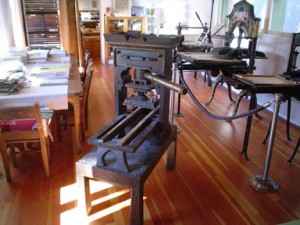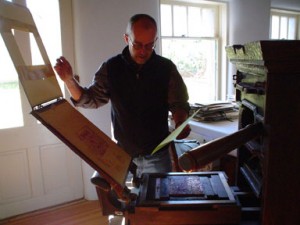 Johannes Gutenberg would be so proud.
Johannes Gutenberg would be so proud.
So is Tom Leech, curator of the Palace Press.
His newest addition to the Press’s collection of 10 major presses — still awaiting formal acceptance — is a Bobcat Press built in the 1970s by Cedar Crest’s Richard Hicks, a machinist turned sculptor who’s spent much of his adult life building replicas of early presses.
The new star of the Palace Press Show is one of about 30 Hicks built out of hand-worked mahogany and poured-brass fittings. He built this one for the Albuquerque Children’s Museum (now called Explora). It was later transferred to the Albuquerque/Bernalillo County Library System’s Center for the Book, which donated it to the Palace Press.
“It’s just a sweet, solid thing,” Leech said of the Bobcat. “It’s a work of art in itself.”
He described the Bobcat as a scaled-down version of the model invented by Gutenberg, who completed the world’s first movable-type press in 1440, revolutionizing the distribution of literature (including the Bible), literacy, and today’s still-existent joy of curling up with a good book. (Or, say, a blog.)
“This has been on – for lack of a better word – my hit list of presses I wanted to acquire, ones that are important to New Mexico printing history,” Leech said. “This almost completes what I’m looking for in terms of printing presses.”
The Palace Print Shop and Bindery, as it’s formally known, is both a New Mexico History Museum exhibit of the state’s publishing history and a working press crafting small batches of books. Its most recent publication is former Santa Fe Poet Laureate Valerie Martinez’s This Is How It Began, featuring marbled-paper covers created by Leech and a calligraphic title page by Santa Fe artist Patty Hammarstedt.
Housed in what were once the stables for the Palace of the Governors, the Palace Press features a recreation of famed artist Gustave Baumann’s print studio, a variety of historic presses and more than 200 fonts of type commonly used in 19th- and early 20th-century publications.
Printing on the Bobcat requires sopping ink onto the printing plate with a large, leather-covered printer’s ball. (In the day, pressmen were known to use the phrase “Sop up your balls” in reference to that activity.)
Each piece of paper was individually slipped into the tympan, which was then lowered onto the plate. The package would be literally pressed by pulling a handle that engages a large wooden screw, thrusting the platen downward.
Though it’s a tad messy and needs a bit of strength to operate the lever , the Bobcat could be – ahem – pressed into service as soon as Dec. 10 during the annual Christmas at the Palace event. Traditionally, visitors are invited to produce a holiday card using a press from the collection.
, the Bobcat could be – ahem – pressed into service as soon as Dec. 10 during the annual Christmas at the Palace event. Traditionally, visitors are invited to produce a holiday card using a press from the collection.
“It’s a size that’s kid-friendly,” Leech said of the Bobcat.
Hicks, one of the heroes of the Battle of Iwo Jima, was still pulled by his love of building presses as recently as 2006, when he told Pamela S. Smith, author of Passions in Print: Private Press Artistry in New Mexico 1834-present, that he just might have to get out his wood-working tools again.
“I’d like to build one more press,” he said, “so that I could print into eternity.”
